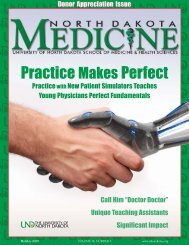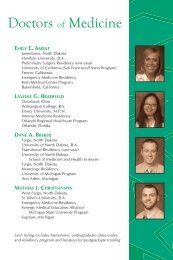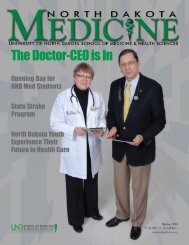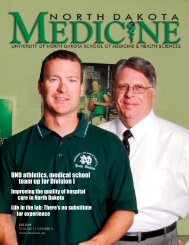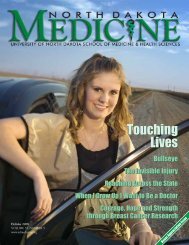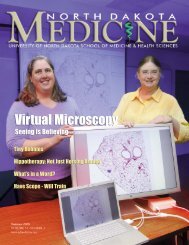Fall 2006 - North Dakota Medicine
Fall 2006 - North Dakota Medicine
Fall 2006 - North Dakota Medicine
- No tags were found...
Create successful ePaper yourself
Turn your PDF publications into a flip-book with our unique Google optimized e-Paper software.
MANY OF US IN OUR LATER YEARSsuffer from a disease that is mostnoticeable when getting up in themorning, walking down stairs or simplyspending time on our feet. The diseaseis osteoarthritis and most of us feel itseffects as we age or as our jointsexperience excessive wear. For some,the pain can be unbearable.Disease of the Bone and JointsOsteoarthritis is caused by agradual deterioration of cartilage, thetough yet elastic tissue that covers theends of long bones and cushions joints.This very common disease can becaused by an injury or by the agingprocess.At least 50 million adults in theUnited States alone and close to 15percent of the worlds adult populationsuffer from this painful and disablingdisease. There is no cure and there arefew treatments that have been shown toslow the progression of the disease.Current treatments mostly decrease thepain that results when the cartilagewears away and bone rubs against bone.Since joining UND in 2002, GeneHomandberg, Ph.D., professor andchair of the biochemistry and molecularbiology department, has formed a team toinvestigate cartilage damage. They arehard at work studying osteoarthritis inorder to provide a better understandingof the diseases progression and to testpossible treatments that may slow theprogression or even reverse the damageof osteoarthritis.One of his teams recent studiesthat looks at the effects of glucosamineand chondroitin sulfate on cartilagedamage soon will be published in thejournal Osteoarthritis and Cartilage,one of the two top journals thatpublishes biochemical studies ofosteoarthritis.Supplemental TreatmentGlucosamine and chondroitinsulfate are naturally occurring foodsupplements that many take in over-thecounterpill form to alleviate joint pain.In their study, Homandbergs teamincluding Danping Guo, M.S., LindaRay, B.S. and graduate student, LeiDing, B.S. found that these agents notonly prevent cartilage damage, but canactually restore cartilage in theirlaboratory model for the disease.Prior to this study, many researchersbelieved that a patient cant get enoughglucosamine and chondroitin sulfatethrough supplements to make adifference, said Homandberg.However, he and his teamdemonstrated that these agents, atconcentrations as low as found in patientstaking these supplements, are effectiveat preventing cartilage damage and evenrestoring tissue in cultured cartilage.Recent clinical studies havesuggested that these supplements dohave a weak effect but only in patientswith severe cartilage damage, saidHomandberg. However, our resultsstill leave open the possibility thattaking these supplements earlier couldslow the progression of cartilagedamage in those patients predisposed tosevere osteoarthritis.This work will bring attention toUND, Homandberg said. More andmore people are interested in the roleof nutrition and supplements inmaintaining healthy cartilage and payattention to new discoveries that theythink may provide a higher quality oflife. Babyboomers are especiallyinterested in staying active in their lateryears and so many magazines and Websites provide extensive coverage ofobservations such as ours.-Amanda ScurryWEB EXCLUSIVE:To learn more aboutosteoarthritis and Homandbergsresearch, visit: www.ndmedicine.orgNORTH DAKOTA MEDICINE <strong>Fall</strong> <strong>2006</strong> 17



